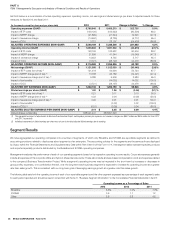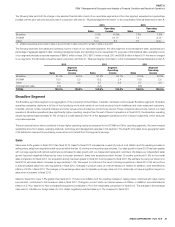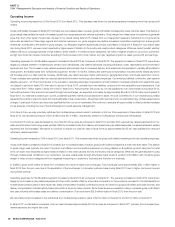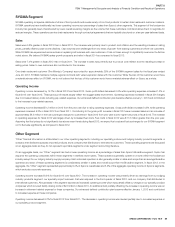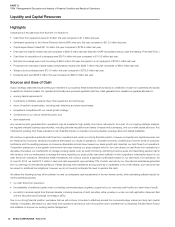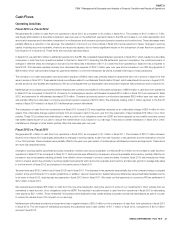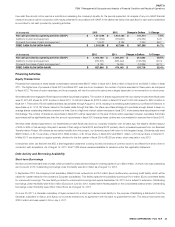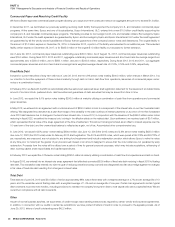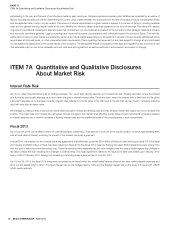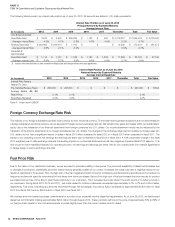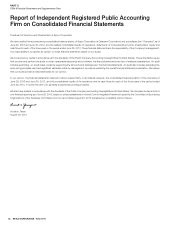Sysco 2013 Annual Report Download - page 47
Download and view the complete annual report
Please find page 47 of the 2013 Sysco annual report below. You can navigate through the pages in the report by either clicking on the pages listed below, or by using the keyword search tool below to find specific information within the annual report.
SYSCO CORPORATION-Form10-K36
PARTII
ITEM7Management’s Discussion and Analysis of Financial Condition and Results of Operations
Critical Accounting Policies and Estimates
The preparation of nancial statements in conformity with generally accepted accounting principles requires us to make estimates and assumptions that
affect the reported amounts of assets, liabilities, sales and expenses in the accompanying nancial statements. Signi cant accounting policies employed
by Sysco are presented in the notes to the nancial statements.
Critical accounting policies and estimates are those that are most important to the portrayal of our nancial condition and results of operations. These
policies require our most subjective or complex judgments, often employing the use of estimates about the effect of matters that are inherently uncertain.
We have reviewed with the Audit Committee of the Board of Directors the development and selection of the critical accounting policies and estimates
and this related disclosure. Our most critical accounting policies and estimates pertain to the allowance for doubtful accounts receivable, self-insurance
programs, company-sponsored pension plans, income taxes, vendor consideration, goodwill and intangible assets and share-based compensation.
Allowance for Doubtful Accounts
We evaluate the collectability of accounts receivable and determine the appropriate reserve for doubtful accounts based on a combination of factors. We
utilize speci c criteria to determine uncollectible receivables to be written off, including whether a customer has led for or has been placed in bankruptcy,
has had accounts referred to outside parties for collection or has had accounts past due over speci ed periods. Allowances are recorded for all other
receivables based on analysis of historical trends of write-offs and recoveries. In addition, in circumstances where we are aware of a speci c customer’s
inability to meet its nancial obligation, a speci c allowance for doubtful accounts is recorded to reduce the receivable to the net amount reasonably
expected to be collected. Our judgment is required as to the impact of certain of these items and other factors as to ultimate realization of our accounts
receivable. If the nancial condition of our customers were to deteriorate, additional allowances may be required.
Self-Insurance Program
We maintain a self-insurance program covering portions of workers’ compensation, general liability and vehicle liability costs. The amounts in excess of
the self-insured levels are fully insured by third party insurers. We also maintain a fully self-insured group medical program. Liabilities associated with these
risks are estimated in part by considering historical claims experience, medical cost trends, demographic factors, severity factors and other actuarial
assumptions. Projections of future loss expenses are inherently uncertain because of the random nature of insurance claims occurrences and could be
signi cantly affected if future occurrences and claims differ from these assumptions and historical trends. In an attempt to mitigate the risks of workers’
compensation, vehicle and general liability claims, safety procedures and awareness programs have been implemented.
Company-Sponsored Pension Plans
Amounts related to de ned bene t plans recognized in the nancial statements are determined on an actuarial basis. Two of the more critical assumptions
in the actuarial calculations are the discount rate for determining the current value of plan bene ts and the expected rate of return on plan assets. Our
Retirement Plan was frozen in scal 2013 and is only open to a small number of employees. Our SERP was frozen in scal 2013. Due to these plan freezes,
our assumption for the rate of increase in future compensation is no longer a critical assumption.
For guidance in determining the discount rates, we calculate the implied rate of return on a hypothetical portfolio of high-quality xed-income investments for
which the timing and amount of cash out ows approximates the estimated payouts of the pension plan. The discount rate assumption is reviewed annually
and revised as deemed appropriate. The discount rate for determining scal 2013 net pension costs for the Retirement Plan, which was determined as
of the June30,2012 measurement date, decreased 113 basis points to 4.81%. The discount rate for determining scal 2013 net pension costs for the
SERP, which was determined as of the June30,2012 measurement date, decreased 104 basis points to 4.89%. The SERP was remeasured during scal
2013 upon approval to freeze the plan. The remeasured discount rate was 3.96%. The combined effect of these discount rate changes increased our net
company-sponsored pension costs for all plans for scal 2013 by an estimated $87.7million. The discount rate for determining scal 2014 net pension
costs for the Retirement Plan, which was determined as of the June29,2013 measurement date, increased51 basis points to 5.32%. The discount rate
for determining scal 2014 net pension costs for the SERP, which was determined as of the June29,2013 measurement date, increased 98 basis points
to 4.94%, as compared to the discount rate upon the remeasurement of the plan during scal 2013. The combined effect of these discount rate changes
will decrease our net company-sponsored pension costs for all plans for scal 2014 by an estimated $5.0million. A 100 basis point increase (or decrease)in
the discount rates for scal 2014 would decrease (or increase) Sysco’s net company-sponsored pension cost by $10.1million. Now that Sysco’s pension
plans are frozen, net company-sponsored pension cost is not as sensitive to discount rate changes as compared to when these plans were active.


